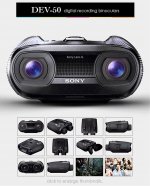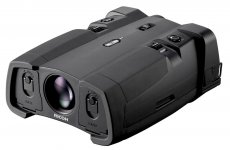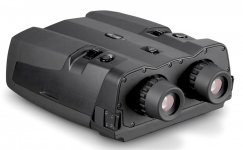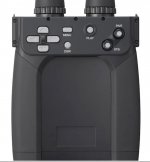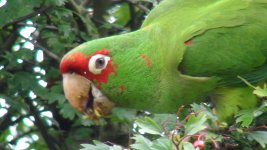While there's been various attempts at this sort of hybrid/ fusion technology, to date there's not been a success - at least at the level of consumer products
As Jerry indicates, the technology has been discussed before on the forum, with perhaps the most recent instance at:
https://www.birdforum.net/showthread.php?t=383344
A) SONY
Sony has developed two lines of combined digital binoculars/ digital recording cameras, without significant market impact
Sony DEV-3 and DEV-5
There’s a two page article dating from the 2011 release in Digital Camera Review at:
http://www.digitalcamerareview.com/news/sony-dev-3-and-dev-5-binoculars-record-stills-and-hd-video/
Sony DEV-30 and DEV-50
These date from 2013, and were 30% smaller and lighter. See the attached image of the DEV-50
The basic details can be found at:
https://www.digitaltrends.com/photography/sony-unveils-dev-50-digital-recording-binocular/
And there is also a 1 3/4 minute video by Sony on youtube (dramatic music and images, basic technical detail) at:
https://www.youtube.com/watch?v=gG4Y9mKmHOU
Usefully there's a review of the DEV-50, by the late Michael Reichmann of Luminous Landscape at:
https://luminous-landscape.com/sony-dev-50/
Along with a review of the DEV-30, compared to a conventional camera at:
https://thenaturaltraveller.net/2014/01/26/the-sony-dev-30-vs-lumix-fz200-for-bird-photography/
And another critical review of the DEV-50 at:
https://jamesrome.net/drupal/DEV-50V
B) RICOH
In 2016, the Ricoh NV-10A digital binocular (actually a binoviewer) was introduced. The recommended retail price was US $4.2k
It used a 1/3” colour CMOS sensor, and provided magnification from around 6.6x to 13.2x
Each eyepiece provided an image of 720 x 480 effective pixels
The external dimensions were 225 x 166 x 83 mm, and the weight was 1.3 kg without the battery (nearly twice that of the Sony DV-50)
It included image stabilisation, and used digital processing to both:
- remove atmospheric interference such as rain, snow, fog and smoke (!), and
- enhance twilight viewing
There’s some information on Cloudy Nights at:
https://www.cloudynights.com/topic/549427-see-through-fog/
And the original link to the Ricoh site included in the thread is still active
See the attached brochure along with some clearer images
However, the fact that there is so little information on the net indicates that production/ demand was again very limited
John






